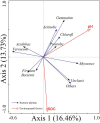Effect of Cultivated Pastures on Soil Bacterial Communities in the Karst Rocky Desertification Area
- PMID: 35966668
- PMCID: PMC9368201
- DOI: 10.3389/fmicb.2022.922989
Effect of Cultivated Pastures on Soil Bacterial Communities in the Karst Rocky Desertification Area
Abstract
Soil bacteria play an important role in regulating the process of vegetation restoration in karst ecosystems. However, the effects of vegetation restoration for different cultivated pastures on soil bacterial communities in the karst rocky desertification regions remain unclear. Therefore, we hypothesized that mixed pasture is the most effective for soil bacterial communities among different vegetation restorations. In this study, we systematically studied the soil properties and soil bacterial communities in four vegetation restoration modes [i.e., Dactylis glomerata pasture (DG), Lolium perenne pasture (LP), Lolium perenne + Trifolium repens mixed pasture (LT), and natural grassland (NG)] by using 16S rDNA Illumina sequencing, combined with six soil indicators and data models. We found that the vegetation restoration of cultivated pastures can improve the soil nutrient content compared with the natural grassland, especially LT treatment. LT treatment significantly increased the MBC content and Shannon index. The vegetation restoration of cultivated pastures significantly increased the relative abundance of Proteobacteria, but LT treatment significantly decreased the relative abundance of Acidobacteria. Soil pH and MBC significantly correlated with the alpha diversity of soil bacterial. Soil pH and SOC were the main factors that can affect the soil bacterial community. FAPROTAX analysis showed LT treatment significantly decreased the relative abundance of aerobic chemoheterotrophs. The results showed that the bacterial communities were highly beneficial to soil restoration in the LT treatment, and it confirmed our hypothesis. This finding provides a scientific reference for the restoration of degraded ecosystems in karst rocky desertification areas.
Keywords: Illumina sequencing; cultivated pasture; karst rocky desertification; soil bacterial community; soil properties; vegetation restoration.
Copyright © 2022 Song, Xiong, Chi, He, Fang and He.
Conflict of interest statement
The authors declare that the research was conducted in the absence of any commercial or financial relationships that could be construed as a potential conflict of interest.
Figures





Similar articles
-
Response of grassland ecosystem function to plant functional traits under different vegetation restoration models in areas of karst desertification.Front Plant Sci. 2023 Dec 12;14:1239190. doi: 10.3389/fpls.2023.1239190. eCollection 2023. Front Plant Sci. 2023. PMID: 38148857 Free PMC article.
-
Effects of different grassland use patterns on soil bacterial communities in the karst desertification areas.Front Microbiol. 2023 Aug 31;14:1208971. doi: 10.3389/fmicb.2023.1208971. eCollection 2023. Front Microbiol. 2023. PMID: 37720153 Free PMC article.
-
Soil Bacterial Community Structure and Co-occurrence Pattern during Vegetation Restoration in Karst Rocky Desertification Area.Front Microbiol. 2017 Dec 1;8:2377. doi: 10.3389/fmicb.2017.02377. eCollection 2017. Front Microbiol. 2017. PMID: 29250053 Free PMC article.
-
Soil nutrients, enzyme activities, and bacterial communities in varied plant communities in karst rocky desertification regions in Wushan County, Southwest China.Front Microbiol. 2023 Jun 14;14:1180562. doi: 10.3389/fmicb.2023.1180562. eCollection 2023. Front Microbiol. 2023. PMID: 37389350 Free PMC article.
-
Karst rocky desertification progress: Soil calcium as a possible driving force.Sci Total Environ. 2019 Feb 1;649:1250-1259. doi: 10.1016/j.scitotenv.2018.08.242. Epub 2018 Aug 26. Sci Total Environ. 2019. PMID: 30308895
Cited by
-
Response of grassland ecosystem function to plant functional traits under different vegetation restoration models in areas of karst desertification.Front Plant Sci. 2023 Dec 12;14:1239190. doi: 10.3389/fpls.2023.1239190. eCollection 2023. Front Plant Sci. 2023. PMID: 38148857 Free PMC article.
-
Effects of rocky desertification on soil bacterial community in alpine grasslands of the Qinghai-Tibet Plateau.Front Microbiol. 2025 Jan 6;15:1485069. doi: 10.3389/fmicb.2024.1485069. eCollection 2024. Front Microbiol. 2025. PMID: 39845040 Free PMC article.
-
Effects of different grassland use patterns on soil bacterial communities in the karst desertification areas.Front Microbiol. 2023 Aug 31;14:1208971. doi: 10.3389/fmicb.2023.1208971. eCollection 2023. Front Microbiol. 2023. PMID: 37720153 Free PMC article.
-
Characterization of Soil Bacterial Communities in Different Vegetation Types on the Lava Plateau of Jingpo Lake.Microorganisms. 2025 Jul 11;13(7):1648. doi: 10.3390/microorganisms13071648. Microorganisms. 2025. PMID: 40732157 Free PMC article.
-
Research Progress of Grassland Ecosystem Structure and Stability and Inspiration for Improving Its Service Capacity in the Karst Desertification Control.Plants (Basel). 2023 Feb 8;12(4):770. doi: 10.3390/plants12040770. Plants (Basel). 2023. PMID: 36840118 Free PMC article. Review.
References
-
- Bao S. D. (2000). Soil and Agricultural Chemistry Analysis. Beijing: China Agriculture Press.
-
- Baptistella J. L. C., de Andrade S. A. L., Favarin J. L., Mazzafera P. (2020). Urochloa in tropical agroecosystems. Front. Sustain. Food Syst. 4:119.
-
- Bonner M. T. L., Allen D. E., Brackin R., Smith T. E., Lewis T., Shoo L. P., et al. (2020). Tropical rainforest restoration plantations are slow to restore the soil biological and organic carbon characteristics of old growth rainforest. Microb. Ecol. 79 432–442. 10.1007/s00248-019-01414-7 - DOI - PMC - PubMed
LinkOut - more resources
Full Text Sources

